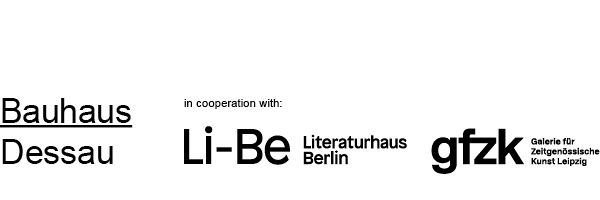Gropius House || Fictional
October 4, 2020–March 14, 2021
The new exhibition of the Bauhaus Residency, second in the series Gropius House || Fictional, is on view until March 14, 2021 in the Directors’ House of the ensemble of the Masters’ Houses in Dessau. The writer Kristof Magnusson and the artist Jan Tichy have created new works for the interior and exterior of Gropius House. In a unique way, their works Fensterbilder (Window Pictures) and Don’t forget to like and subscribe relate to the architecture of the World Cultural Heritage Site in Dessau and the annual theme of the foundation Habitat.
Jan Tichy: Fensterbilder (Window Pictures)
In his Dessau work Fensterbilder, Jan Tichy refers to Oskar Schlemmer’s final group of works of the same name, created in Wuppertal in 1942. In his months in Dessau, Tichy lived and worked in Schlemmer’s Master’s House. But Tichy has also been examining the photographic works of two other Bauhaus artists, László Moholy-Nagy and Lucia Moholy, for many years.
“The Bauhaus architecture here came into my practice a couple of years ago while exploring the relationship between photography of Lucia Moholy and the architecture of Walter Gropius. One of the crucial questions in this relation has been: Who owns the image? The question of ownership is a profound one for design and architecture in relationship to photography. When Lucia Moholy was here, photographing with her two cameras, she was the only one photographing – everybody else was living here. Today, nobody is living here, but everybody who comes here has a camera and the amount of photographs taken here resonates with the ideas of Lucia and László Moholy-Nagy on production and reproduction as well as with Moholy’s famous prediction that one day everybody will walk around with a camera.”
Kristof Magnusson: Don’t forget to like and subscribe
During his short but intensive stay at the Bauhaus Residency, the novelist Magnusson focused on his own working processes: When does writing begin, where does research end? How do the surroundings influence his own working processes? What effect does the past of a place have on the people who inhabit it? Magnusson dealt with these and other questions in the video works he created for the exhibition in Gropius House, they are presented on an aluminium flat-screen iMac from 2007 and a plastic tube monitor iMac from 2000.
For Magnusson, the futuristic design of the tube monitor iMac, which after twenty years is already a museum object, expresses an optimism about the future that he also recognizes in the Bauhaus: the historical school of design was ultimately based on the conviction that a better future is conceivable and achievable. The two iMacs thus are representative of a paradoxical condition that also holds true for the Bauhaus: some things have long since become part of history and nevertheless still reference the visions of the future inscribed in them.
The artists
Jan Tichy (born in Prague in 1974) lives in Chicago and teaches at the School of the Art Institute of Chicago. He works with the media of photography, video, and sculpture, and his works are exhibited and collected around the world. As an art mediator, Tichy sees himself as part of a pedagogical history derived from the Bauhaus.
Kristof Magnusson (born in Hamburg in 1976) is a novelist and playwright, journalist and translator. He studied at the Deutsches Literaturinstitut Leipzig and at the University of Reykjavík, and regularly gives seminars and workshops at international schools of writing and universities.
The Bauhaus Dessau Foundation is a non-profit foundation under public law. It is institutionally funded by the German Federal Commissioner for Culture and the Media, the State of Saxony-Anhalt, and the City of Dessau-Roßlau. The Bauhaus Residency Programme Gropius House || Fictional is a cooperation project of:

